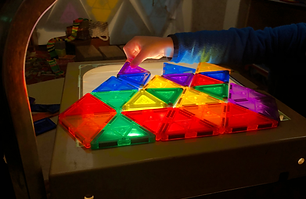Light and Shadows
An old overhead projector sparked a rich, multi-faceted exploration of light and shadows, inspiring children to engage in storytelling, scientific observation, and collaborative play both indoors and outdoors.
By Kathryn Derler, ECE



Initial Invitation
Our exploration into light and shadows began with the donation of an old overhead projector from a parent. We set it up on a classroom table, accompanied by loose parts, transparent sheets, and whiteboard markers. The children immediately and confidently engaged with the new tool and its many possibilities.
What followed were rich conversations and imaginative play, with the projector becoming a source of ‘movies,’ storytelling, and performance. Children began drawing different sets, adding characters using loose parts, and narrating their stories. On one occasion, there was nothing on the projector glass at all—it simply became a stage, where children took turns performing and showcasing their skills. Interestingly, the familiar materials they had used for storytelling and building only started being referred to as “movies” once illuminated by the projector light. Children would carefully arrange their pieces and invite others to the “movie theatre” to watch the show.



Underwater Movie
One memorable moment came when a child gathered all the sea creatures from the loose parts box and carefully placed them on the projector glass. He spent 15 minutes arranging and rearranging the pieces, stepping back to admire his work, and adding to the story on the whiteboard.
“How it looks?” he asked an educator.
“How do you think it looks?” she replied.
“First, we need to make this much more better,” he said, walking back to revise the arrangement on the transparencies.
Later, a friend joined him at the projector and began flipping the metal flap that shifts the light angle. “That’s like a lighthouse!” he exclaimed.




Light Display
In another moment, a child used colourful transparent magnet tiles to cover the projector glass entirely. While working, he noticed the mirror above the light and remarked, “Everything is smaller.”
Later, as an educator adjusted the projector arm, she commented, “I’m trying to make it look sharper.” He walked to the wall, touched the projected image, and replied: “They don’t feel sharp!”


Garage Door Project
One student, known for his love of garages, brought this passion into the light exploration. Using his usual combination of magnet tiles, he recreated a garage door and placed it on the projector glass. He closely observed how the light shone through the colours as he folded and unfolded the tiles, deepening his investigation into structure and function through light.



Light and Shadows Outdoors
Outside, the children extended their exploration of light through their shadows. As the sunny weather returned, many noticed their shadows on walks to the forest and initiated shadow-chasing games with educators and peers. They commented on how their shadows disappeared in the shade, or imagined leaving them behind:
“I brought my shadow with me.”
“Oh no! I lost my shadow!”
“I forgot my shadow at home.”
This led to closer observation of shadow features. Many noted that while you can see ears in your shadow, you cannot see eyes or mouths:
“You can’t see your mouth, but you can see your ears in your shadow!”
Reflections
As children engaged with light, shadows, and projection, their curiosity guided rich play and inquiry. They explored scientific concepts, artistic expression, and social connection. Their discoveries sparked collaborative storytelling, deepened peer relationships, and encouraged a greater understanding of their environment. This inquiry reminds us that with just a small spark, like the arrival of an old projector, children will illuminate the world with their ideas.


